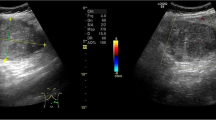Abstract
Torsion of the adnexa can be the cause of abdominal pain. An immediate diagnosis is very important because early surgical intervention is the only way to save the ovary from necrosis. Torsion of a normal adnexa is rare, but occurs more frequently than is generally appreciated. If US findings are equivocal, MRI can provide additional information. In our case the MRI findings leading to the diagnosis of ovarian torsion were: (a) A medial ovarian mass existed with dislocation of the uterus to the affected side with hyperintense, cystic lesions on T2-weighted images at the periphery of the ovary. (b) Beaked protrusion of the mass continuing in a band-like structure connecting it with the uterus obviously represented the Fallopian tube. (c) Low and inhomogeneous signal intensity of the stroma on T1- and T2-weighted images and lack of gadolinium uptake were indicative of infarction.
Similar content being viewed by others
References
Berger RL, Robins G (1961) Torsion of the normal ovary. Am J Surg 102: 716–719
Kimura I, Togashi K, Kawakami S, Takakura K, Mori T, Konishi J (1994) Ovarian torsion: CT and MR imaging appearances. Radiology 190: 337–41
Davis AJ, Feins NR (1990) Subsequent asynchronous torsion of normal adnexa in children. J Pediatr Surg 25: 687–689
DiSaia PJ (1990) Ovarian disorders. In: Scott JR, DiSaia PJ, Hammond CB, Spellacy WN (eds) Danforth's obstetrics and gynecology, 6th edn. Lippincott, Philadelphia, pp 1067–1120
Surratt JT, Siegel MJ (1991) Imaging of pediatric ovarian masses. RadioGraphics 11: 533–548
Mashiach S, Bider D, Moran O, Goldenberg M, Ben-Rafael Z (1990) Adnexal torsion of hyperstimulated ovaries in pregnancies after gonadotropin therapy. Fertil Steril 53: 76–80
Graif M, Itzchak Y (1987) Sonographic evaluation of ovarian torsion in childhood and adolescence. AJR 150: 647–649
Stark JE, Siegel MJ (1994) Ovarian torsion prepubertal and pubertal girls: sonographic findings. AJR 163: 1479–1482
Rosado WM, Trambert MA, Gosink BB, Pretorius DH (1992) Adnexal torsion: diagnosis by using Doppler sonography. AJR 159: 1251–1253
Hall BP, Printz DA, Roth J (1993) Massive ovarian edema: ultrasound and MR characteristics. J Comput Assist Tomogr 17: 477–479
Author information
Authors and Affiliations
Additional information
Correspondence to: G. Ranner
Rights and permissions
About this article
Cite this article
Bader, T., Ranner, G. & Haberlik, A. Torsion of a normal adnexa in a premenarcheal girl: MRI findings. Eur. Radiol. 6, 704–706 (1996). https://doi.org/10.1007/BF00187677
Received:
Revised:
Accepted:
Issue Date:
DOI: https://doi.org/10.1007/BF00187677




